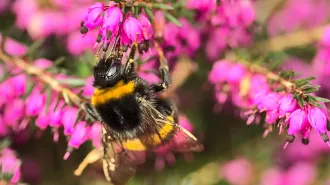Looking good to wow the opposite sex may be bad for the neighborhood. Distinctive his-and-her plumages raise the chance that a bird species will go extinct locally, according to an unusually far-ranging study.

In many bird species, a male’s plumage differs from a female’s, notes Paul F. Doherty Jr. of Colorado State University in Fort Collins. After analyzing 21 years of birdwatchers’ records across the United States, Doherty and his colleagues report that bird species with such gender gaps in their plumage color were 23 percent more likely to disappear from a locale than were species with unisex plumage. Many local extinctions were temporary, however. Birds of the same species from nearby neighborhoods later recolonized the depleted area, the researchers report in an upcoming Proceedings of the National Academy of Sciences (PNAS).
Biologists take gender-specific plumage as a sign that the demands of winning a mate, instead of just the rigors of daily survival, influence a species’ evolution. Theorists as far back as Charles Darwin have mused that this sexual selection imposes hardships, or costs, on animals. Sexy colors, for example, might attract predators or require extra foraging for pigment-rich foods.
Such costs showed up in smaller studies, including ones indicating that birds with sex differences in plumage were more likely than others to disappear on Tahiti and other islands. Another study found that flashy spots attractive to the opposite sex shrink over generations in guppies living with aggressive predators.
Thanks to a volunteer effort called the Breeding Bird Survey, the new study takes an unusually broad look at the cost of sexual selection, says Doherty. For decades, birdwatchers have surveyed the United States by recording species in breeding season at specified stops along thousands of preset routes. Doherty and his colleagues have used novel methods for analyzing data on animals’ presence in particular spaces.
The researchers compared 153 species showing plumage differences between the genders with 185 that have no such color differences, at least not ones that people can see. In data covering 2 decades, the scientists indeed found a significantly greater chance of local disappearances in the species with plumage differences. The pattern of local extinction didn’t correlate with the birds’ body size, nest type, or preferred breeding habitat, says Doherty.
The general pattern of local extinctions didn’t hold across two areas: Southern Texas and a region of the northern prairie, says Doherty. “You can start to make [up] all kinds of stories,” he says.
Peter Bennett of the Institute of Zoology in London, who also studies the dynamics of extinction, asks whether the bird species in the survey really made the best test of the idea. People have changed habitats across so much of the United States that these species “have already been through a filter of extinction,” he says.
In a commentary in PNAS, Nils Stenseth and Glenn-Peter Stre of the University of Oslo, say that the new results “might have important implications for our understanding of the ecological dynamics and evolution of biotic communities, as well as on how we are to best protect threatened species.”
****************
If you have a comment on this article that you would like considered for publication in Science News, send it to editors@sciencenews.org. Please include your name and location.






